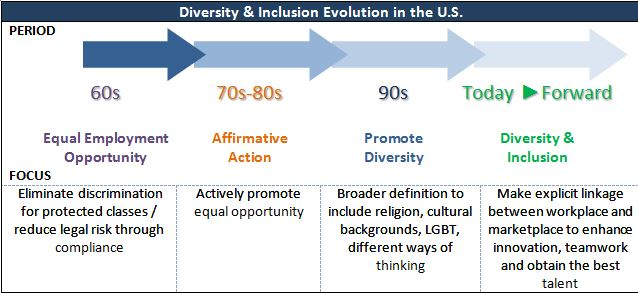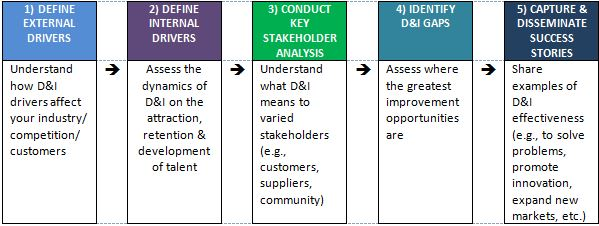ATD Blog
Diversity & Inclusion: Making the Business Case
Wed Jun 12 2013


Diversity & Inclusion (D&I) is crucial to building global profits, developing top talent, and responding effectively to changing customer requirements. However, D&I execution often falls short of intended targets. Despite intense competition to reach new markets and attract global talent, D&I has a long way to go to become embedded in the regular operations of companies today.
Making a compelling business case is a critical step that sometimes is overlooked.
An understanding of D&I has evolved over time, from an early focus on compliance to today’s understanding that D&I is a critical part of how we must do business going forward.
With changing demographics, more demanding customers, and mobility across borders, organizations must shift how they attract, retain, and develop talent, creating a more inclusive environment that leverages diversity effectively. However, we must make the business case explicit so that D&I isn’t seen as a practice focused solely on being “politically correct,” or as a window dressing process.
As Baby Boomers age, more minorities enter the workforce, veterans return to the workplace, and nearly one in five people have some kind of disability, we must find talent from new sources and create a more inclusive environment. Failure to do so means losing talent to your competitors.
Here are five steps to help you begin to build your D&I business case:
Define external drivers that set the context in which your organization needs to operate to be successful. Conduct research about where growth is occurring and where existing and emerging competition is focusing. Collect data about how your organization’s customers and requirements are shifting, and what the implications are from a D&I perspective.
Define internal drivers that show how increased competition for talent requires organizations to find the best people in new ways, and—once they successfully recruit them—foster an inclusive environment in which talent capabilities and contributions are encouraged and captured. Consider where some of the pain points in your organization exist—relating to turnover, diverse talent in leadership roles, effectively mirroring your customer base, and so forth.
Conduct key stakeholder analysis to understand how various internal functions (such as IT, marketing, HR, operations, procurement, supply chain, and legal) need to adapt to changing demographics. Next, examine external stakeholders (such as customers, suppliers, market analysts, and government agencies) and how their perspectives are shifting in response to seismic demographic change.
Identify key gaps which may be related to turnover of diverse talent, skills shortages, missed market opportunities, and so forth that provide the “burning platform” for organizational commitment to D&I.
Capture and disseminate success stories that demonstrate “what good looks like” when D&I is leveraged to foster innovation, mirror the customer base, improve problem solving capabilities, and promote higher engagement within the organization.
Once you have defined your business case, use multiple vehicles to communicate the message to various stakeholders. These channels can include:
Infographics that summarize the D&I business case through graphs and illustrations
Town hall meetings led by senior leaders that make the link between D&I and organizational strategy explicit
Video success stories available on your organization’s intranet
“Meeting in a box” materials that help leaders to create an effective dialogue about D&I with their teams
D&I tool kits that educate employees about today's demographic and market realities and define best practices for employees and leaders to execute daily.
There is compelling evidence that focusing on D&I brings bottom line results: During a 10-year period, the index of publicly traded companies in DiversityInc.’s Top 50 Companies for Diversity outperformed NASDAQ by 28 percent, S&P 500 by 25 percent, and the Dow Jones Industrial Average by 22 percent, according to Catalyst.
How will you define the D&I business case that addresses the marketplace, workplace, and community so that it becomes a “call to action” and propels your organization forward? Share your thoughts in the comment section below.
Check back for more posts this month on D&I and plan to attend the ASTD webcast, Best Practices in Diversity and Inclusion: A Panel Discussion on July 10, 2013, to hear more about this topic from a panel of D&I leaders from different industries.
